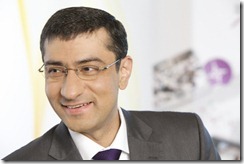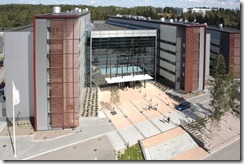Earlier this year Nokia Siemens Networks’ (NSN) CEO Rajeev Suri said he believed it was not sustainable for there to be five global telecom technology companies and that consolidation was inevitable at some stage. Comm. looks at whether NSN is doing enough to avoid being the victim of consolidation rather than the beneficiary of it 
Rajeev Suri is leading a strategy for which NSN will look to specialise in managed services alongside mobile broadband, innovation, and quality
Rajeev Suri is adamant that Ericsson, Huawei, NSN, Alcatel-Lucent, and ZTE cannot continue in their present, independent forms for all that much longer. His comments may prove prophetic, though ironically it is the organisation that he leads that faces as real a challenge for survival as any of the other four global telecom technology players.
The global economic crisis that took hold in 2008 is likely to be a further catalyst to the demise or re-organisation of one, and perhaps even more than one of the leading telecom suppliers. Investment in infrastructure continues to be relatively sluggish as service providers remain cautious about the outlook of their businesses. Competition is also intense amongst the suppliers themselves, with long, brutal battles of attrition for the awards of new contracts not being uncommon.
For the first quarter of 2012 to end-March, NSN reported operating losses of €1 billion (US$1.28 billion), and net sales decline of seven per cent year-on-year to €2.95 billion. The company attributed the fall primarily to a decline in sales of infrastructure equipment, which it said, however, was more than offset by a slight increase in sales of services. The sequential decline in NSN’s net sales in the first quarter 2012, the company said, was driven primarily by industry seasonality.
At constant currency, NSN’s net sales would have decreased nine per cent year-on-year and 24 per cent sequentially.
Tellingly, Chinese competitor Huawei is said to have overtaken NSN as the second-largest wireless infrastructure company in the world in terms of sales in the final quarter of 2011, according to ABI Research.
Huawei sold US$2.53 billion worth of equipment, up 54 per cent on the previous quarter and 38 per cent compared to the same quarter a year ago.
In contrast, NSN managed to generate US$2.4 billion in equipment sales during the same period.
Services already account for around 50 per cent of NSN’s revenues, with managed services growing the fastest, based on engagements in 180 operators around the world serving a total of 700 million subscribers. Suri has identified managed services alongside mobile broadband, innovation, and quality as NSN’s three-pronged strategy to beat the competition.
NSN has achieved some strong headway in the LTE space given the early commercialisation of networks in places like the US, Japan and Saudi Arabia. The telecom technology company currently holds 52 LTE contracts, which represents the most held by any other supplier to-date.
“We have established deep, trust-based relationships with customers with respect to mobile broadband,” Suri said. “There was a time when customers would have penalised us for no longer being an end-to-end provider, but not anymore,” he added.
NSN’s new strategic focus was articulated in November 2011 when the company stated its intention to reduce its global workforce, which stood at 74,000 on November 1, 2011 by approximately 17,000 or 23 per cent by the end of 2013. The planned reductions were expected to be driven by aligning the company’s workforce with its new strategy as well as through a range of productivity and efficiency measures.
At the time, NSN said it would target end-to-end mobile network infrastructure and services, with a particular emphasis on mobile broadband. The realignment was set to help the company focus its resources on mobile broadband (including optical), customer experience management, and services. 
A view of NSN headquarters in Finland – market commentators doubt the long-term sustainability of five distinct global telecom technology providers
“Achieving an operating profit of 5-10 per cent is our long-term plan,” Suri said. In February he stated that 1,000 people had already come off the payroll since the November announcement, and that the programme would continue throughout the year affecting 55 countries, 30 of them in Europe.
“We expect NSN’s LTE market share to more than double this year from a revenue perspective,” Suri said, with the company expecting traction from LTE deployments across the globe to boost its performance in 2012. Current LTE uptake is skewed to the US market given the country counts approximately 60 per cent of the world’s LTE subscribers at the moment, though Suri forecasts that the technology’s introduction in other parts of the world will be to the telecom technology provider’s advantage.
“In Japan and Korea our position in LTE is very different (than it is in the US),” Suri said. “In Japan for example, NSN is the largest foreign wireless vendor, and in Korea we have been successful as a greenfield entry,” he added.
However, there is still some ways to go before the restructuring programme meets its stated aims. NSN is targeting to reduce its annualised operating expenses and production overheads by €1 billion by the end of 2013, compared to the end of 2011. While these savings are expected to come largely from organisational streamlining, NSN announced it would also target areas such as real estate, information technology, product and service procurement costs, overall general and administrative expenses, and a significant reduction of suppliers in order to further lower costs and improve quality.
The on-going restructuring and streamlining exercise is intensive business with NSN announcing at the beginning of March that it was cutting further jobs following the end of a managed services deal, and outsourcing some of its R&D activities.
Published reports suggested the company was cutting 3,500 jobs in Brazil, following the end of a managed services agreement with operator Oi. It gained 3,000 staff from the operator and third-parties as part of a deal in 2009.
NSN has also gone on to sign an agreement with Nordic IT services company Tieto to outsource part of the maintenance, technical support and R&D for NSN’s mobile network operations support system (OSS) and subscriber data management (SDM) activities in Finland.
This deal saw 240 staff transferring to Tieto, a company that already employs 18,000 staff.
NSN is also reported to have partnered with Juniper Networks for the launch of their Integrated Packet Transport Network solution, which is intended to address the need of service providers to simplify the network architecture by integrating multiple layers into a simple, scalable design that improves the economics of the core network infrastructure.
Customer experience management is another area that NSN would like to focus on, believing it has unparalleled network intelligence tools to offer.
“One billion records are being collected every minute on live networks,” Suri said. Such information can be collated and utilised to provide better services to end-users, as well as to better understand their requirements and preferences, thereby widening the selection of products and services available to them.
NSN is placing much emphasis on its Liquid Net suite of products, aimed at boosting the operation of mobile broadband networks
NSN is also placing a lot of emphasis on its Liquid Net suite of products, which include Liquid Radio, Liquid Core, Liquid Transport, and Liquid Net end-to-end Intelligent Broadband Management, which are all aimed at unleashing frozen network capacity into a reservoir of resources. The products enable a broadband network to instantly adapt to unpredictable changes in end-user demand and boosts network utilisation.
Liquid Radio helps eliminate the limitations of conventional radio access network architecture, while Liquid Core helps the core network to dynamically adapt itself to provide the capacity needed to ensure the best customer experience at the lowest cost. Liquid Transport is geared to help channel traffic along the path of least resistance through the network, while the Intelligent Broadband Management allows for the integration of traffic management and content management to create a more valuable mobile broadband experience while efficiently using the minimum network capacity.
A clear delineation appears to be becoming apparent between Ericsson and Huawei driving to become end-to-end solutions providers, and NSN, Alcatel-Lucent, and ZTE preferring an approach based on developing niche areas of specialisation in which to invest resources and dominate. It is likely therefore, that consolidation pressure will come from the specialist technology providers, and it is likely to be down to whose strategy implementation is most astute that differentiates the acquirer from the acquired.





0 comments ↓
There are no comments yet...Kick things off by filling out the form below.
Leave a Comment